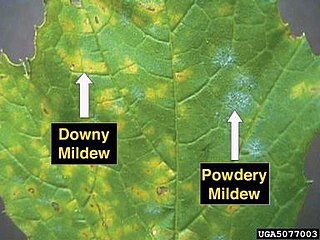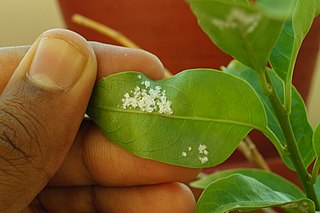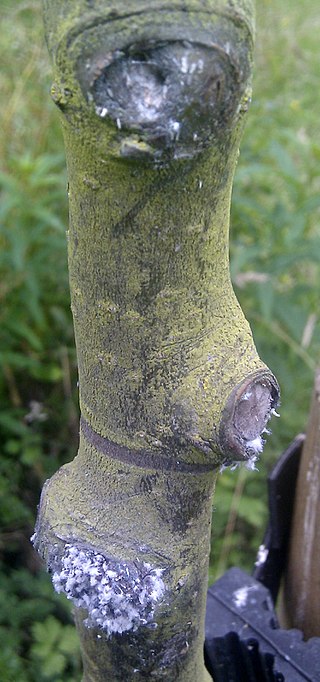
Armillaria is a genus of fungi that includes the A. mellea species known as honey fungi that live on trees and woody shrubs. It includes about 10 species formerly categorized summarily as A. mellea. Armillarias are long-lived and form the largest living fungi in the world. The largest known organism covers more than 3.4 square miles (8.8 km2) in Oregon's Malheur National Forest and is estimated to be 2,500 years old. Some species of Armillaria display bioluminescence, resulting in foxfire.

Mildew is a form of fungus. It is distinguished from its closely related counterpart, mould, largely by its colour: moulds appear in shades of black, blue, red, and green, whereas mildew is white. It appears as a thin, superficial growth consisting of minute hyphae produced especially on living plants or organic matter such as wood, paper or leather. Both mould and mildew produce distinct offensive odours, and both have been identified as the cause of certain human ailments.

Scale insects are small insects of the order Hemiptera, suborder Sternorrhyncha. Of dramatically variable appearance and extreme sexual dimorphism, they comprise the infraorder Coccomorpha which is considered a more convenient grouping than the superfamily Coccoidea due to taxonomic uncertainties. Adult females typically have soft bodies and no limbs, and are concealed underneath domed scales, extruding quantities of wax for protection. Some species are hermaphroditic, with a combined ovotestis instead of separate ovaries and testes. Males, in the species where they occur, have legs and sometimes wings, and resemble small flies. Scale insects are herbivores, piercing plant tissues with their mouthparts and remaining in one place, feeding on sap. The excess fluid they imbibe is secreted as honeydew on which sooty mold tends to grow. The insects often have a mutualistic relationship with ants, which feed on the honeydew and protect them from predators. There are about 8,000 described species.

Onoclea sensibilis, the sensitive fern, also known as the bead fern, is a coarse-textured, medium to large-sized deciduous perennial fern. The name comes from its sensitivity to frost, the fronds dying quickly when first touched by it. It is sometimes treated as the only species in Onoclea, but some authors do not consider the genus monotypic.

Woolly aphids are sap-sucking insects that produce a filamentous waxy white covering which resembles cotton or wool. The adults are winged and move to new locations where they lay egg masses. The nymphs often form large cottony masses on twigs, for protection from predators.

Sooty mold is a collective term for different Ascomycete fungi, which includes many genera, commonly Cladosporium and Alternaria. It grows on plants and their fruit, but also environmental objects, like fences, garden furniture, stones, and even cars. The mold benefits from either a sugary exudate produced by the plant or fruit, or honeydew-secreting insects or sap suckers the plant may be infested by.

The beech blight aphid is a small insect in the order Hemiptera that feed primarily on the sap of American beech trees. The aphids form dense colonies on small branches and the undersides of leaves. A secondary host, based on their geographic location, is the roots of the bald cypress (Taxodium distichum), where some aphids alternate between hosts and others remain with Taxodium distichum year-round.

Damping off is a horticultural disease or condition, caused by several different pathogens that kill or weaken seeds or seedlings before or after they germinate. It is most prevalent in wet and cool conditions.
Microfungi or micromycetes are fungi—eukaryotic organisms such as molds, mildews and rusts—which have microscopic spore-producing structures. They exhibit tube tip-growth and have cell walls composed of chitin, a polymer of N-acetylglucosamine. Microfungi are a paraphyletic group, distinguished from macrofungi only by the absence of a large, multicellular fruiting body. They are ubiquitous in all terrestrial and freshwater and marine environments, and grow in plants, soil, water, insects, cattle rumens, hair, and skin. Most of the fungal body consists of microscopic threads, called hyphae, extending through the substrate in which it grows. The mycelia of microfungi produce spores that are carried by the air, spreading the fungus.
Schiffnerula cannabis is a plant pathogen infecting hemp. It is one of the many 88 species of fungi which attack Cannabis and with time. The black mildew of Cannabis, compared to gray mold caused by Botrytis cinerea, and the problems it causes are often not extreme as opposed to the gray mold with the potential to wipe a crop in merely a week.

Capnodiales is a diverse order of Dothideomycetes, initially based on the family Capnodiaceae, also known as sooty mold fungi. Sooty molds grow as epiphytes, forming masses of black cells on plant leaves and are often associated with the honeydew secreted by insects feeding on plant sap. This diverse order has been expanded by the addition of several families formerly thought unrelated and now also includes saprobes, endophytes, plant pathogens, lichens and rock-inhabiting fungi. The new additions include the genus Mycosphaerella containing the causal agents of several economically important crop and tree diseases. A small number of these fungi are also able to parasitise humans and animals, including species able to colonise human hair shafts.

Coccus viridis is a soft scale insect in the family Coccidae with a wide host range. It is commonly known as green scale or sometimes coffee green scale because it is a major pest of coffee crops throughout the world.

Scorias spongiosa is a sooty mould fungus that grows on aphid honeydew. It is a member of the Capnodiaceae family of ascomycete fungi. It is found only on American beech trees, Fagus grandifolia.

Coccus hesperidum is a soft scale insect in the family Coccidae with a wide host range. It is commonly known as brown soft scale. It has a cosmopolitan distribution and feeds on many different host plants. It is an agricultural pest, particularly of citrus and commercial greenhouse crops.

Eriosoma lanigerum, the woolly apple aphid, woolly aphid or American blight, is an aphid in the superfamily Aphidoidea in the order Hemiptera. It is a true bug and sucks sap from plants.

Phenacoccus solenopsis, the cotton mealybug or solenopsis mealybug, is a species of mealybug in the family Pseudococcidae. Having originated in North America, it has spread to other parts of the world and become a major pest of cotton crops.
Stanley John Hughes (1918–2019) was a Canadian scientist who is known throughout the global field of mycology for developing and introducing a precise and meticulous system for classifying fungi that is still used today. A naturalized Canadian, he was a federal research scientist for Agriculture and Agri-Food Canada at what is today the Ottawa Research and Development Centre.

Toumeyella parvicornis is a soft scale insect in the family Coccidae with a wide host range. It is commonly known as pine tortoise scale because of the characteristic appearance of the mature females, which look like tiny tortoises up to 1/4 inch in diameter.















